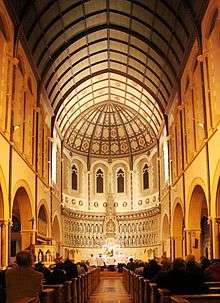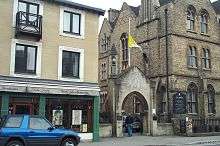Oxford Oratory
| Oxford Oratory | |
|---|---|
 Oxford Oratory | |
| Coordinates: 51°45′34″N 1°15′42″W / 51.759343°N 1.261763°W | |
| Location | Oxford |
| Country | England |
| Denomination | Roman Catholic |
| Architecture | |
| Heritage designation | Grade II listed |
| Architect(s) | Joseph Hansom |
| Completed | 1875 |
| Administration | |
| Diocese | Roman Catholic Archdiocese of Birmingham |
The Oxford Oratory Church of St Aloysius Gonzaga (or Oxford Oratory for short) is the Catholic parish church for the centre of Oxford, England. It is located at 25 Woodstock Road. The church is served by the Congregation of the Oratory.
History

St. Aloysius' was originally founded as the Jesuit (Society of Jesus) parish of central Oxford. Completed in 1875, the building of St. Aloysius' was an important step in the on-going refoundation of a Roman Catholic presence in Oxford. The parish was served by notable members of the Society for many years - including Gerard Manley Hopkins (December 1878–September 1879). The Church also housed a notable collection of relics bequeathed by Hartwell de la Garde Grissell, many of which were destroyed in the 1970s.
In the 1980s, the Jesuits left the church and the parish was taken over by the Archdiocese of Birmingham. In 1990, the Archbishop of Birmingham invited members of the Birmingham Oratory to take over the running of the parish and found a new Oratorian community in Oxford. Two priests from Birmingham arrived in September 1990 and, in 1993, the Oxford Oratory was established as an independent Congregation.
Liturgy
It is part of the tradition of the Oratory in England to ensure that the liturgy is celebrated in a dignified and worthy manner. Most Masses are celebrated in English, though Mass is also celebrated every Sunday and Holyday in Latin in both the ordinary and the 1962 extraordinary form of the Roman Rite. There is also a said Latin Mass each Wednesday evening.
The main focus of the liturgical life of the parish is the Solemn Mass on a Sunday. As is the tradition of the English Oratories, it is celebrated in Latin (Ordinary Form) with both deacon and subdeacon. The choir sings Mass settings in Latin and motets in many different styles.
Organ
The organ was enlarged between 1998 and 2004 by Matthew Copley. A specification of the organ can be found on the National Pipe Organ Register.[1]
Building
The church was designed by Joseph Hansom in a Gothic Revival style.[2] Much of the original interior decoration was painted over in the 1970s, and the altar moved forward. The building is being gradually restored as part of the "Oxford Oratory - Reaffirmation & Renewal" campaign.
The church consists of a single nave and five side chapels. To the left of the sanctuary is the Sacred Heart chapel, and the Lady Chapel is to the right. There are also chapels dedicated to St Philip Neri (formerly St Joseph's chapel) and Our Lady of Oxford (also known as the relic chapel). There are plans to build a new baptistery and a chapel dedicated to Cardinal Newman after his beatification in September 2010.
Gallery
 Church altar
Church altar Church sanctuary
Church sanctuary View of the altar
View of the altar
External links
| Wikimedia Commons has media related to Oxford Oratory. |
- Map sources for Oxford Oratory
- Official website
- The Latin Mass Society of England & Wales
- Latin Masses in Oxford
- Historic England. "Details from image database (245940)". Images of England.
References
- ↑ http://www.npor.org.uk/cgi-bin/Rsearch.cgi?Fn=Rsearch&rec_index=K00223
- ↑ Harris, Penelope, "The Architectural Achievement of Joseph Aloysius Hansom (1803-82), Designer of the Hansom Cab, Birmingham Town Hall and Churches of the Catholic Revival", The Edwin Mellen Press, 2010, ISBN 0-7734-3851-3
